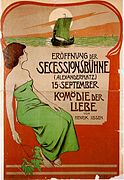Plakatstil

Plakatstil (German for "poster style"), also known as Sachplakat, was an early style of poster art that originated in Germany in the 1900s.[1] It was started by Lucian Bernhard of Berlin in 1906. The common characteristics of this style are bold eye-catching lettering with flat colors.[2] Shapes and objects are simplified, and the composition focuses on a central object. Plakatstil turned away from the complexity of Art Nouveau and propagated a more modern outlook on poster art. Famous Plakatstil artists include Ludwig Hohlwein, Edmund Edel, Ernst Deutsch-Dryden, Hans Lindenstadt, Julius Klinger, Julius Gipkens, Paul Scheurich, Karl Schulpig and Hans Rudi Erdt.[3] A later master of the Sachplakat was Otto Baumberger.
Das Plakat was a German art magazine that was published from 1910 to 1921 by the Verein der Plakatfreunde ("association of friends of the poster"), founded in 1905 and later edited by the Berlin dentist Hans Sachs. Lucian Bernhard was a director of the association.[4]
Gallery[edit]
-
Edmund Edel, theatre poster for Komödie der Liebe by Henrik Ibsen
-
Julius Klinger: Möhring candelabra factory, 1908
-
Hans Rudi Erdt, Manoli, 1911
-
Das Plakat special issue on The Movie, October 1920; cover by Paul Leni
References[edit]
- ^ Consuegra, David, American type design & designers, 2004, pg. 288
- ^ "Plakatstil". Csun.edu. Archived from the original on 2019-09-08. Retrieved 2014-08-19.
- ^ Rabinowitz, Tova (2006-02-28). Exploring Typography (Illustrated ed.). Cengage Learning. ISBN 1401815057. Retrieved 2012-06-12.
- ^ Heller, Steven (1910-01-13). "Graphic Design Magazines: Das Plakat by Steven Heller". Typotheque. Retrieved 2014-08-19.
External links[edit]




